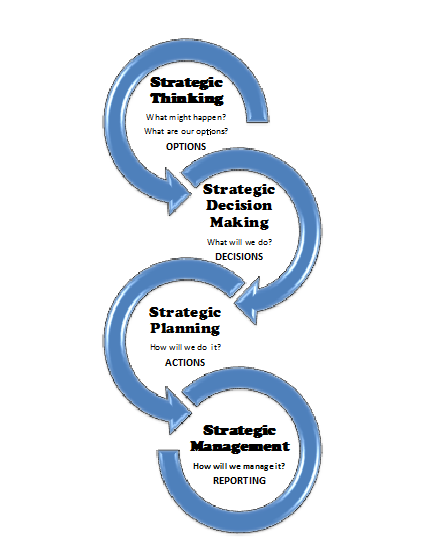Competition is the lifeblood of business, as all organisations compete – either directly or indirectly – for scarce resources. Your success depends on your ability to think strategically, how you compete or how you choose to play – your strategy. Effective strategies begin with strategic thinking, not strategic planning.
Effective strategy development consists of four components, or stages of development:
- Strategic Thinking;
- Strategic Decision-Making;
- Strategic Planning; and
- Strategic Management (or Strategy Execution).

Many people confuse strategic planning with strategy – hence the annual strategic planning conference that has become institutionalised in many organisations. But planning is only the 3rd step in an effective strategy development process.
Famed business thinker Henry Mintzberg pronounced the demise of strategic planning as long ago as 1994 in his seminal HBR article “The Fall and Rise of Strategic Planning”.[1]
“When strategic planning arrived on the scene in the mid-1960s, corporate leaders embraced it as “the one best way” to devise and implement strategies that would enhance the competitiveness of each business unit.
While certainly not dead, strategic planning has long since fallen from its pedestal. But even now, few people fully understand the reason: strategic planning is not strategic thinking. Indeed, strategic planning often spoils strategic thinking, causing managers to confuse real vision with the manipulation of numbers. And this confusion lies at the heart of the issue: the most successful strategies are visions, not plans.”

Strategic Thinking
This is where genuine strategy is anchored. It requires consideration of the world around you and how it is likely to evolve in the future. It involves identifying unique business insights and opportunities that can create competitive advantage.
The critical question is not “what?”, but “why?” or “why not?” and “how?” It is more about connecting the dots than finding the dots.
As a leader of your organisation, then, your first job is to think. Too much action without thinking can end in tears. What things might cause a change? What could happen? What can you do about it? Can you be a leader, or is better to be a follower?
Check out what is happening down the road – what are others looking at? What changes are being considered or introduced? What about in other countries?
Strategic Decision-Making
Thinking strategically will generate various options and alternative courses of action. There are many roads to Rome. It is up to you to decide which one, and Google Maps is of limited use.
Analysis is an important and essential input into the decision-making process, but there is always a danger of ‘analysis paralysis”. Often the future variables are hard to quantify and your analysis will inevitably be dependant on the assumptions that underpin it. Just look at the results of government budget forecasting, with all the resources and expertise that underline them as an example of the complexities and probabilities of success.
Strategic decision-making often involves an element of faith. Pursuit of vision and a clear sense of purpose are essential for this to work. There will always be risks and unforseen circumstances ahead, but commitment and consistency will generally overcome these.
So once you’ve figured out what you want or need to do – be decisive. Don’t be tempted to water down your vision – a strong commitment adds value.
Strategic Planning
 Strategic planning is what happens between thinking and execution.
Strategic planning is what happens between thinking and execution.
Don’t confuse strategic planning with strategy development – it only answers the question of how you are going to go about what it is you have decided to do. Once again
– not everyone gets this, planning is only really strategy if it follows a period of thinking strategically.
This is where we look at the “how to?” What resources will be committed? Over what time period? How will we measure success?
Strategic Management
For strategy to be effective, it needs deep commitment to execution. This begins internally – many excellent strategies have failed because a Board or the management group is not wholly behind it.
All aspects of the organisation’s day-to-day functioning need to be fully aligned to the strategy, just as they need to be fully aligned to organisational purpose and values.
Where the strategy moves the organisation in a new direction, every individual needs to be fully aligned with it. Job descriptions, performance measures, bonus and reward structures all need to reflect the strategic direction.
Sometimes there are individuals who cannot move in line with chosen the strategic direction. These may be Board members, they may be Managers. When an individual, for whatever reason, continues to attempt to discredit or white-ant the strategy, they should be removed as their actions can be fatal. Cohesion is essential for success.
Constant review of key success measures is also critical. All plans need refinement and adjustment over time, and this can only occur successfully when we know what does and does not work.
In Conclusion
In a world where technology is changing rapidly, with the competitive framework constantly evolving in response, an understanding of these shifts is essential. This is the heart of strategic thinking, which allows you to develop suitable strategies and competitive responses. These decisions are then the ones which can give you a competitive edge. But they will only do so if the entire organisation is aligned behind them.
© David Shelton, Principal, Transition Capital, May 2017
[1] http://hbr.org/1994/01/the-fall-and-rise-of-strategic-planning/ar/1
